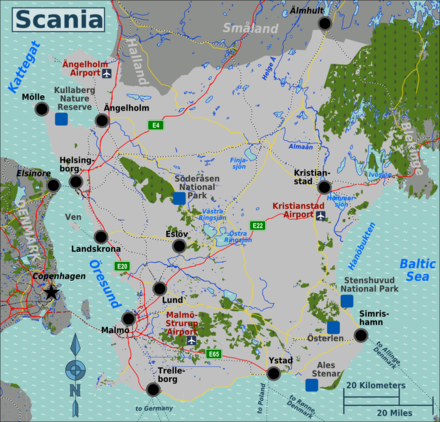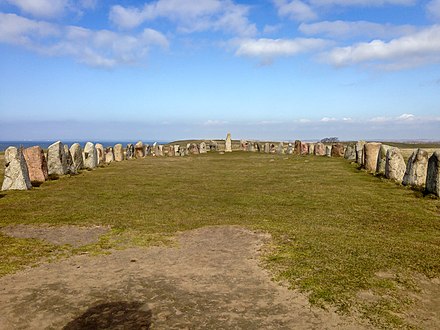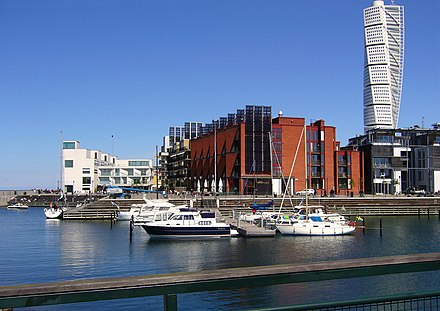Scania - historical province in Sweden

Scania (dead link: March 2023) (Swedish: Skåne) is the southernmost county, as well as a traditional province, in Sweden. It is known for its rich agricultural fields, its old history, long beaches, Danish heritage and a distinguishable accent. With 1.25 million inhabitants, it is one of the most populous and densely inhabited regions of Sweden, with a strong local identity.
Cities
- Ängelholm - known for its 6 km long beach and for clay pigeons - a kind of ocarina
- Åstorp
- Båstad
- Eslöv
- Helsingborg - the gateway to Denmark, with Helsingör 5 km across the Öresund
- Höganäs
- Höör
- Kävlinge
- Kristianstad
- Landskrona
- Lund - famous for its long-standing university and cathedral.
- Malmö - the third largest city of Sweden, which evolved from an industrial city centered around a shipyard to a modern model of a sustainable community with one of the best biking infrastructures in the world
- Mölle - small picturesque port town. Known for views and fish dishes.
- Simrishamn
- Trelleborg - Sweden's southernmost city
- Vellinge
- Ystad - home of fictional detective Kurt Wallander, created by Henning Mankell
Other destinations

- Ales Stenar — a 67-metre-long stone ship formed by 59 large boulders of sandstone, a megalithic monument from the Nordic Iron Age
- Kullaberg Nature Reserve
- Österlen — picturesque southeastern district
- Stenshuvud National Park
- Söderåsen National Park
- Ven Island
Understand
See also: Nordic history
During the 10th century, Scania was conquered by Danish king Harald Bluetooth, and remained under Danish rule for the most part of the next 700 years. Harald founded Lund, where a cathedral was built during the Middle Ages, making the city Scania's political centre. The Dano-Swedish wars during the 16th and 17th centuries devastated the province. In January 1658, Swedish King Charles X Gustav made the bold decision to lead his army from Jutland on a march across the ice towards Zealand. The Danes surrendered, and in the Roskilde treaty the same year they were forced to cede Scania, and several other territories, to Sweden. King Charles XI enforced a brutal assimilation policy in Scania, which included the foundation of the university in Lund, to promote the Swedish language. Dano-Swedish hostilities continued into the early 18th century, but Scania has remained a part of Sweden since then, though with a strong identity on its own.
Scania contains Sweden's most productive farmland, and since the completion of the Öresund Bridge in 1999, Malmö and Lund form a prosperous urban region together with Copenhagen. While most of Scania is flat, the ridges and hills in the north-east are significant. Northeastern Scania is an important geoclimatic borderland, as well as the historical borderland between the old Danish lands Scania, Halland and Blekinge and what was then Sweden. Unlike the rest of Scania which was dominated by agriculture, this part is dominated by forestry and mining. Red Spruce and Scots Pine are everywhere, and while the forests may seem "wild" they usually aren't.
Climate
Scania, being furthest south, is the warmest part of Sweden, according to climate data from southwestern Scania. At the height of summer, daily high temperatures average in the low to mid 20s Celsius (low- to mid-70s Fahrenheit) and daily low temperatures average in the low- to mid-teens C (mid to high 50s F). At the height of winter, daily high temperatures average just a few degrees above freezing while daily low temperatures average just below freezing. In mid-spring, daily highs average in the mid-teens C (around 60 °F), daily lows averaging around 5 °C (40 °F). In mid-autumn, daily highs average in the low teens C (around 50 °F), with daily lows averaging around 5 °C (40 °F). Keep in mind that the temperatures may deviate considerably from the average.
The weather tends to be sunniest in late spring and summer, and gloomiest through winter, to the point where the sun is rarely seen. Precipitation remains fairly constant throughout the year, usually taking the form of snow or rain during the winter.
Talk
If you're a beginner Swedish speaker and don't speak it very well, you'll find that the local dialect is hard to understand, at least in the countryside, often even for native Swedish speakers. This accent can be traced back to the endangered local language Scanian (skånska), which once bridged the dialect gap between Swedish and Danish, but which has mostly been replaced by Standard Swedish with a Scanian accent and dialect words. If you do try to speak Swedish and don't understand what you're being told, ask for it to be written down, as the written language is the same.
The good news is that English is spoken by nearly everyone, apart from some elderly people.
Get in
_landscape._Rapeseed_field_near_Maria_Park_outside_Helsingborg.jpg/440px-Sk%C3%A5ne_(Scania)_landscape._Rapeseed_field_near_Maria_Park_outside_Helsingborg.jpg)


By plane
- Copenhagen Airport (Kastrup) (IATA: CPH) in Denmark, is the main international airport of the area, just across the Øresundsbron bridge connecting Denmark and Sweden. A 10-minute trip by train, bus or car takes you from Copenhagen Airport to Skåne. Skånetrafiken trains run from Copenhagen Airport to Malmö and Skåne every 20 minutes, a one-way ticket costs around 100 kr.
- Malmö Airport (dead link: January 2023) (Sturup), 25 km east of Malmö, has air traffic from Stockholm, Hungary, Poland among others. There are Flygbussarna airport coach connections to the cities of Malmö and Lund.
By boat
Scania is connected to Germany, Denmark and Poland by car ferry.
- TT-Line (dead link: January 2023) runs services to Trelleborg from Travemünde and Rostock (Germany) daily.
- Scandlines runs daily services to Trelleborg from Sassnitz (Germany).
- Stena Line runs daily services to Trelleborg from Rostock (Germany).
- Scandlines and HH-Ferries runs very frequent services to Helsingborg from Helsingør (Denmark). The trip takes about 20 minutes and the ships run at least every hour 24/7. Daytime there is a departure every 15 minutes.
- Unity Line and Polferries run daily services from Świnoujście (Poland) to Ystad.
By car
The Öresund Bridge charges a toll, which is 395 kr for a standard car.
Get around
Skånetrafiken (dead link: December 2020) provides comprehensive rail and bus service in the region.
With a flat scenery and milder climate than the rest of Sweden, Scania is suitable for cycling.
- Ventrafiken runs a domestic ferry line between Landskrona and Ven.
By taxi
- Cabonline. Offers TaxiKurir, Taxi 020, Sverigetaxi and TOPCAB taxis. Fixed price on all trips. 2020-08-21
- Uber
See
 Fertile and populous, Scania is more shaped by man than the rest of Sweden, full of palaces, manors and churches.
Fertile and populous, Scania is more shaped by man than the rest of Sweden, full of palaces, manors and churches.
- Sofiero. A palace and gardens just north of Helsingborg, a former royal summer residence and renowned as one of Europe's largest collections of rhododendrons, more than 10,000 plants with 500 different varieties.
- Lund's Cathedral. The foremost Romanesque cathedral in the Nordic Region. Awarded three stars in the Michelin tourist guide.
- Glimmingehus, 55.500833°, 14.230833°. The best-preserved medieval castle in the Nordic region.
- Skåne Zoo. The only Scandinavian zoo with Scandinavian animals only.
- Svarta Bergen ("The Black Quarry"), 56.3950°, 14.250°. Svarta Bergen is a former quarry of black dolerite. Today with a small museum.
- Nytebodaskogen ("Nyteboda forest"), 56.3272°, 14.3962°. Nyteboda forest has been left untouched for close to 200 years, and has some very large pines aged more than 250 years. Interesting plant life including some very rare orchids.
- BRIO Lekoseum, 56.3792°, 13.9933°. Toy museum for the famous Swedish brand of wooden toys.
- Hovddala Slott ("Hovddala Manor"), 56.1044°, 13.7125°. Fortified manor house from early 12th century.
- Sporrakulla Gård, 56.2879°, 14.2418°. Museum farm from around 1700. In summer demonstrations of production of charcoal and tar.
Do
- Hiking on Skåneleden.
- Golf. From central Scania you can reach around 70 golf courses in 50 minutes. Choose from European Tour favourites and tranquil, friendly golf clubs. Barsebäck (dead link: December 2020), host of the Solheim Cup 2003, is classed as the best golf course in Sweden. PGA of Sweden National Golf Resort close to Malmö is considered one of the best golfing centres of northern Europe.
- The relatively mild climate makes Scania appropriate for water sports.
- Cycling through the flat scenery.
- Fishing is pretty good and a lot of people come from Denmark and Germany for that purpose.
- Hunting is also quite common and the great moose hunt takes place in October every year.
- In autumn the forests are prime territory for mushrooms and berries (lingonberry and common bilberry are everywhere).
Eat
See also: Nordic cuisine
As Scania is Sweden's breadbasket, and its gateway to central Europe and historically part of Denmark, traditional Scanian cuisine differs much from the rest of Sweden; known for being sweet, greasy, and salty. Some local delicacies are eel, goose and böckling (smoked herring), and different kinds of dairy products and meats.
Malmö offers a wide selection of haute cuisine and ethnic restaurants (in partiklar Middle Eastern cuisine, and the region of Österlen has a lot to offer in the way of food.
An iconic dessert is spettekaka, a meringue-like dry egg and sugar based dessert that is a must try for anyone visiting the region.
Drink
The toponymous Skåne Akvavit is a brand of hard liquor.
Stay safe
Malmö and other cities have some issues with street crime, but are generally comparably safe.
Go next
- Blekinge
- Bornholm is an island, and the only remnant of Eastern Denmark.
- Småland consists of deep forests.
- Zealand and the Danish capital of Copenhagen
Related: Zealand